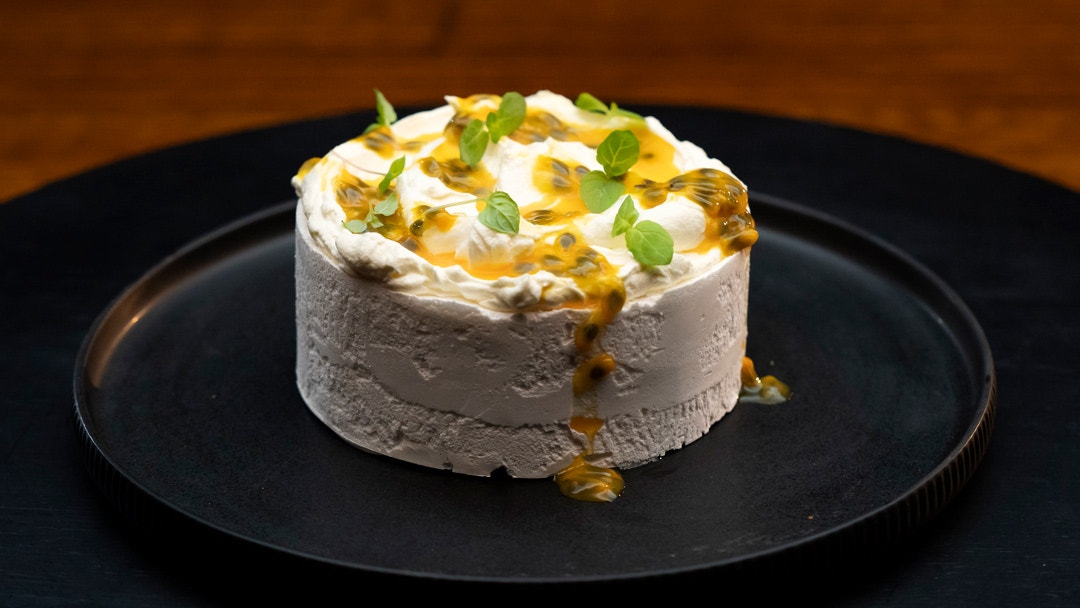Back
Mango Passionfruit Pavlova

- Steps
- Ingredients
Ingredients
Passionfruit Curd
Pavlova Shell
Salted Caramel Cream
Coconut Dacquoise
Crunchy White Chocolate
Vanilla Panna Cotta
Mango Mousse
Yellow Glaze
White Chocolate Collar
Garnishes
To serve
Select All
Steps
- Preheat one oven to 90°C and another to 170°C.
- Set the blast chiller to -30°C.
- Half fill a medium saucepan with water, bring to the boil then reduce to a simmer.
- For the passionfruit curd, soak the gelatine in cold water for 3 minutes to soften. Lift gelatine from the water, squeezing water out. Reserve the bowl of water.
- Meanwhile, grease a 24.5 x 37cm deep baking tray with canola oil spray and line the base with baking paper.
- Remove pulp from passionfruit and pass through a fine sieve, discarding the seeds.
- In a medium bowl, combine 120g seedless passionfruit pulp, eggs, sugar and butter and use a stick blender to process together until just combined.
- Place the bowl over the saucepan of simmering water. Cook the curd, stirring regularly, until mixture reaches 82°C.
- Remove bowl from the heat, reserving the saucepan of simmering water.
- Stir gelatine through curd until dissolved. Strain curd through a fine sieve into prepared tray, 5mm thick.
- Place tray into the blast chiller for 20 minutes to set hard.
- For the pavlova shell, in the bowl of a stand mixer, combine egg whites, caster sugar and scraped vanilla seeds.
- Place the bowl over saucepan of simmering water and whisk by hand until mixture reaches 65°C.
- Remove bowl from the heat, reserving the saucepan of simmering water.
- Transfer meringue mixture to stand mixer fitted with the whisk attachment.
- Whisk on high speed for 8-10 minutes or until whipped to a cool, thick and shiny meringue.
- Meanwhile, lightly grease two 12cm diameter springform cake pans with canola oil spray. Line the base with baking paper. Line the sides of the pan with a 40cm long, 4.5cm wide acetate strip.
- Transfer meringue to a piping bag and cut a 1cm wide opening at the tip. Pipe meringue to cover the inside base and sides of the mould. Use a small palette knife to carefully scrape away any excess, ensuring the meringue covers the interior surface of the mould in a 2mm thick, even layer.
- Place meringue into the 90°C oven to bake for 30 minutes or until dry and hard. Turn the oven off and leave the door ajar to dry out.
- For the salted caramel cream, soak the gelatine in cold water for 3 minutes to soften. Lift gelatine from the water, squeezing water out. Reserve the bowl of water.
- In a medium bowl, combine butter, gelatine and salt and set aside.
- Place a medium saucepan over medium heat to warm. In four batches, gradually add the sugar, stirring with a heat resistant spatula after each addition until caramel is a deep golden brown.
- When the last quarter of sugar has been added to the pan, place cream into a small saucepan and warm to 82°C. Remove from the heat.
- Add the reserved warm cream to the caramel, bring mixture to the boil and stir with a spatula to dissolve caramel in cream. Remove saucepan from the heat. Add eggs to a medium bowl and whisk briefly. Add a third of the hot caramel cream to the eggs and whisk well. Transfer the egg mixture from the bowl back into the saucepan of remaining caramel cream.
- Place the saucepan over medium heat and cook, stirring constantly with a spatula until the mixture reaches 82°C. Remove saucepan from the heat.
- Pour the mixture into the gelatine, butter and salt. Use a stick blender to emulsify. Pass the mixture through a fine sieve over the set Passionfruit Curd, 5mm thick layer.
- Gently tap the tray to level if needed and place back into the blast chiller for 25-30 minutes or until set firm and ready to assemble.
- For the coconut dacquoise, grease and line the base of a 24.5 x 37cm deep baking tray with baking paper.
- Sift the icing sugar into a medium bowl. Add the coconut, mix and set aside.
- In the bowl of a stand mixer fitted with the whisk attachment, combine the egg whites and brown sugar. Whisk to firm peaks on high speed.
- Add the icing sugar/coconut mixture to egg whites and gently fold through.
- Transfer two thirds of the mixture to prepared tray and use a palette knife to spread to a thickness of 5mm.
- Bake at 170°C for 12 minutes or until lightly golden brown all over. Remove from the oven and allow to cool. Run a small sharp knife around the edges. Place a clean sheet of baking paper and a large tray over the Dacquoise and flip to turn over.
- Gently remove the baking paper the Dacquoise was baked on.
- For the crunchy white chocolate, spread the coconut across the base of a deep sided baking tray. Toast coconut in the 170°C oven for 8-10 minutes or until lightly golden, stirring halfway through cooking if edges are cooking too fast. Remove tray from the oven and set aside to cool.
- Meanwhile, place chocolate in a medium bowl and place over the reserved saucepan of simmering water. Leave to melt, stirring periodically.
- Remove bowl from the heat. Reserve the saucepan of water and top up as needed. Whilst both ingredients are hot, add toasted coconut to the melted chocolate and stir through.
- Spread a thin layer of the mixture over the top of the Dacquiose and gently press into the Dacquoise. Transfer tray of Dacquoise to the fridge for the chocolate to set.
- For the vanilla panna cotta, soak the gelatine in cold water for 3 minutes to soften. Lift gelatine from the water, squeezing water out. Reserve the bowl of water.
- In a small bowl, combine caster sugar, agar agar and vanilla seeds and mix well.
- In a medium saucepan, combine milk and half the cream.
- Add sugar mixture and reserved vanilla pod to the milk and cream and bring to the boil over medium heat. Reduce to low heat and simmer whilst stirring for 1 minute.
- Remove saucepan from the heat. Remove vanilla pod. Add soaked gelatine to milk mixture and stir until dissolved. Add the remaining cream and stir through. Pass mixture through a fine sieve into a measuring jug.
- Place a sheet of 11cm diameter shallow silicon ring mould on a flat tray and fill each ring. Place Panna Cotta in the blast chiller to freeze.
- For the coconut dacquoise, use a 6cm round cutter to cut rounds from the Dacquiose. Place the rounds, chocolate side down on a tray and set aside.
- For the mango mousse, soak the gelatine in cold water for 3 minutes to soften. Lift gelatine from the water, squeezing water out. Reserve the bowl of water.
- In the bowl of a stand mixer fitted with the whisk attachment, whip the cream to soft peaks. Place ½ a cup of whipped cream in a small bowl. Reserve both in the fridge.
- Cut cheeks from the mango stone and scoop flesh out with a large spoon. Discard peel and stone. Place mango flesh in the jug of a Thermomix and process for 2 minutes, speed 6 to a smooth puree, scraping the sides with a spatula as needed.
- Add the yolks and sugar to the Thermomix and process for 2 minutes, 85°C, speed 3.5 until mixture reaches 85°C. Turn the heat off, add the gelatine and pulse through until well distributed. Transfer mixture to a medium bowl. Place the bowl over a larger bowl of iced water to cool to 40°C.
- When mixture reaches 40°C, remove bowl from the iced water and fold the larger quantity of whipped cream through. Reserve the iced water.
- Place a sheet of 7.5cm diameter, 2cm deep round silicon moulds onto an oven tray. Spoon Mousse in, to half fill each mould. Set aside at room temperature.
- Remove the curd/caramel tray from the blast chiller and run a sharp knife around the edges. Lift the curd/caramel out onto a chopping board. Use a 6cm round cutter to cut discs out. Discard the trimmings. Place the discs, curd side down onto the Dacquoise discs.
- Take the prepared caramel/curd/dacquoise stack and push and twist it into the centre of mousse mould, caramel side down, until top of dacquoise is level with the top edge of the mould. Use a small palette knife to level off excess Mousse. Place mould back into the blast chiller and freeze for 25 minutes or until set firm.
- For the yellow glaze, soak the gelatine in cold water for 3 minutes to soften. Drain the gelatine, discarding the water.
- Meanwhile, in a medium saucepan, combine milk, glucose and yellow colouring and bring to the boil.
- In a stick blender cannister, combine white chocolate and soaked gelatine.
- Add the hot milk mixture to the jug of chocolate and set aside for 30 seconds. Submerge the blade of the stick blender and without introducing too much air, process until all the chocolate has melted and glaze is smooth and shiny. Tap the cannister on the bench to remove small bubbles.
- Pass the glaze through a fine sieve into a measuring jug. Set aside to cool to 35°C then hold at room temperature.
- For the white chocolate collar, place a strip of acetate 35cm long, 1.5cm wide flat on a clean bench.
- Melt 100g of the chocolate in a medium bowl over reserved saucepan of simmering water. Warm the chocolate to 45°C. Remove bowl from the saucepan. Gradually add remaining chocolate whilst stirring continuously with a spatula to reduce chocolate temperature to 27°C, only adding more chocolate as previous batch melts in the mix. Use the bowl of iced water to very briefly help reduce the temperature if needed. Place the bowl briefly back over the saucepan of simmering water to warm 28-29°C.
- Lay the acetate flat on the bench and spread the tempered chocolate to 1mm thickness. Leave to half set then curl the acetate around a 10cm diameter ring. Place collar onto a small tray and leave to set in the fridge for 10 minutes before gently removing the acetate.
- Set the Chocolate Collar aside at room temperature until needed.
- For the garnishes, peel the mango and cut cheeks from the mango stone. Use a 6cm round cutter to cut a disk from the centre of each cheek, discarding offcuts. Cut the disk into two semi circles. Turn the mango upright, flat side on the board and thinly shave the mango flesh into 1mm thick slices.
- Cut passionfruit in half and place in a small bowl.
- Finally, to serve, turn silicon mould of assembled mousse upside down on a wire rack, set over a deep baking tray. Gently remove dessert from the mould.
- If needed, gently warm the glaze to 35°C. Pour the yellow glaze over the Mousse, letting excess drip off.
- Demould the Panna Cotta and place the larger ring in the centre of the serving plate, vanilla bean side up. Use a 10cm round cutter to cut the frozen Panna Cotta in the centre, discarding the outer ring. Clean the plate if needed.
- Use a 7.5cm round cutter to cut the Panna Cotta in the centre. Place the smaller ring on top of glazed dessert and leave larger ring on the plate.
- Use a small palette knife to lift the entrement from the rack onto the plate, in the centre of the large Panna Cotta ring.
- Fan sliced mango around the glazed Mousse, on top of the large Panna Cotta ring.
- Place White Chocolate Collar around the mango.
- Carefully remove Pavlova Shell from mould and remove acetate and baking paper.
- Carefully dress the top of the Pavlova Shell with whipped cream, passionfruit seeds and micro mint.
- Cover the entremet with the Pavlova Shell.
























